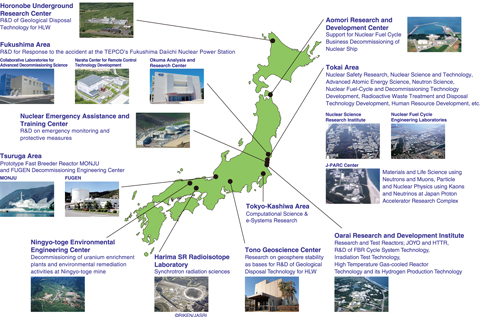This publication introduces the latest research and development (R&D) endeavors in each field of the Japan Atomic Energy Agency (JAEA), with each chapter presenting the activities from one sector. Each of the R&D sectors performs their activities through one or more R&D centers or institutes, which bases spanning one to several sites. These centers and institutes are located throughout Japan, as shown on the map below. The following brief introduction outlines the research undertaken within each sector.
| 1. | The Sector of Fukushima Research and Development promotes R&D regarding the decommissioning and environmental restoration corresponding to the accident at the Fukushima Daiichi Nuclear Power Station (1F) of Tokyo Electric Power Company Holdings, Inc. (TEPCO). This sector also promotes the development of the R&D infrastructure that is essential to the 1F decommissioning efforts. |
| 2. | The Nuclear Safety Research Center and Nuclear Emergency Assistance and Training Center in the Sector of Nuclear Safety Research and Emergency Preparedness perform research into safety measures that support the national nuclear safety bodies that regulate nuclear facilities (such as nuclear power plants) at the Nuclear Science Research Institute. They also perform R&D regarding nuclear emergency monitoring and protective measures at Hitachinaka City, Ibaraki Prefecture. |
| 3. | The Advanced Science Research Center in the Sector of Nuclear Science Research explores novel disciplines in advanced atomic energy sciences to develop theories and investigate novel phenomena, materials, and technologies. In particular, seven research themes have been organized under three divisions: advanced actinides science, advanced nuclear materials science, and advanced theoretical physics. |
| 4. | The Nuclear Science and Engineering Center in the Sector of Nuclear Science Research carries out fundamental research into various key technologies that are required for nuclear energy use at the Nuclear Science Research Institute. |
| 5. | The Materials Sciences Research Center and J-PARC Center in the Sector of Nuclear Science Research are engaged in research using neutrons at the Nuclear Science Research Institute and the Japan Proton Accelerator Research Complex (J-PARC). Research using synchrotron radiation is performed at the Harima SR Radioisotope Laboratory. |
| 6. | The Reactor Systems Design Department and HTGR Research and Development Center in the Sector of Fast Reactor and Advanced Reactor Research and Development at the Oarai Research and Development Institute further the development of High-Temperature Gas-cooled Reactor (HTGR) technology, technology for hydrogen production through high-temperature water splitting, and technology for helium gas turbines. |
| 7. | The Reactor Systems Design Department, Fuel Cycle Design Department, Fast Reactor Cycle System Research and Development Center, and Tsuruga Comprehensive Research and Development Center in the Sector of Fast Reactor and Advanced Reactor Research and Development aim to establish fast reactor (FR) cycles to address long-term energy security and global environmental issues. This work includes enhancing the safety of the FR system at the Oarai Research and Development Institute, compiling the results on the Prototype Fast Breeder Reactor Monju (MONJU), attaining inspection and repair technologies for the FR system at the Tsuruga Comprehensive Research and Development Center, and manufacturing plutonium fuel and reprocessing spent FR fuel at the Nuclear Fuel Cycle Engineering Laboratories in cooperation with the Sector of Nuclear Fuel, Decommissioning and Waste Management Technology Development. |
| 8. | The Sector of Nuclear Fuel, Decommissioning and Waste Management Technology Development develops technologies for the safety and rational decommissioning of nuclear power facilities as well as measures for processing and disposing of radioactive waste. It operates at the Aomori Research and Development Center, the Nuclear Fuel Cycle Engineering Laboratories, and the Ningyo-toge Environmental Engineering Center. The sector also performs multidisciplinary R&D that is aimed at improving the reliability of the geological disposal of high-level radioactive waste in Japan. One key field is the establishment of techniques for evaluating the long-term stability of the geological environment, carried out at the Tono Geoscience Center. The main focus at the Horonobe Underground Research Center and the Nuclear Fuel Cycle Engineering Laboratories is on safety assessment and improving technologies for the design of geological disposal facilities; an additional focus at the Nuclear Fuel Cycle Engineering Laboratories is on developing nuclear fuel cycle technology. |
| 9. | The Center for Computational Science & e-Systems aims to advance simulation technologies and fundamental technologies in computational science as well as the operation and maintenance of computer systems and networks. These activities are mainly conducted at the Nuclear Science Research Institute and the Kashiwa Office. |
| 10. | The Integrated Support Center for Nuclear Nonproliferation and Nuclear Security (ISCN) plays an active role in strengthening nuclear nonproliferation and nuclear security in both the domestic and international arenas. This is achieved through its many activities, including the development of technologies for IAEA safeguards and nuclear detection and forensics, policy research and analysis, capacity-building support activities targeting Asian countries, operation of CTBT international monitoring facilities located in Japan, and coordination and support for nuclear fuel transportation undertaken by JAEA. These efforts are carried out mainly at Head Office and the Nuclear Science Research Institute. |

<Previous: Contents | Next: 1 Research and Development Related to the Accident at the TEPCO’s Fukushima Daiichi NPS>